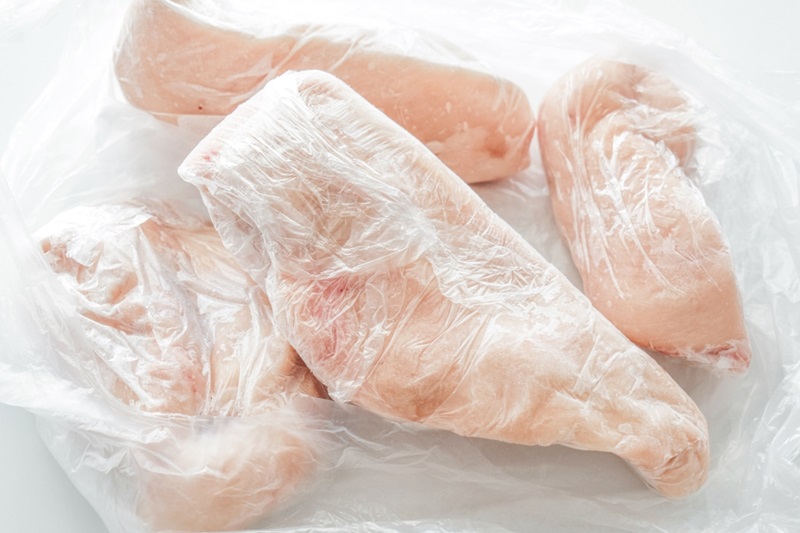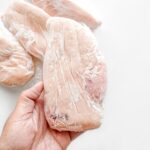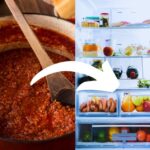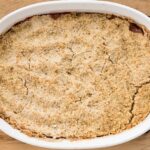Chicken is considered a “risky food” by many as it is particularly prone to contamination by harmful bacteria such as salmonella and campylobacter.
These bacteria can cause foodborne illnesses if the chicken is improperly handled, prepared, and cooked.
If you have frozen chicken, thawing the chicken is a routine but critical step in meal preparation. You should never cook chicken from frozen—proper defrosting is essential! However, one question lingers: How long after defrosting chicken should it be cooked to guarantee safety and quality?
Here, we delve into food safety, exploring the recommended timelines, best practices, and essential tips for handling defrosted chicken to help you ensure every meal is delicious and safe.
How Soon Do You Have to Cook Chicken After Defrosting?
Once you’ve defrosted chicken, it’s important to cook it promptly. The UK Food Standards Agency (FSA) recommends cooking chicken immediately after thawing.
This is because bacteria can multiply more rapidly at temperatures between 8°C and 60°C, known as the “danger zone.”
Within this temperature range, bacteria can double in number every 20 minutes. Such fast bacterial growth leads to a rapid increase in their population on the surface of the meat.
Consuming chicken that contains harmful bacteria can result in stomach upset and food poisoning, but cooking thawed chicken immediately limits the amount of bacterial growth and improves food safety.
With that said, the time you have to eat chicken after it has defrosted depends on how you have chosen to thaw frozen chicken:
- If you’ve defrosted the chicken in the fridge, it’s generally safe for up to 1 to 2 days. The cooler temperatures within your fridge keep chicken out of the “danger zone” as it thaws.
- If you’ve used the microwave or cold water method for thawing, the chicken should be cooked immediately after defrosting as per FSA guidelines.
How Long Can Thawed Chicken Stay Out?
Once your chicken is thawed, it should not be left out at room temperature for an extended period.
The general guideline is to avoid leaving thawed chicken out for over two hours. If the ambient temperature is higher than 30°C, the time should be limited to one hour.
This is because, as mentioned, bacteria can multiply rapidly at temperatures above 8°C, increasing the risk of foodborne illness. In warmer weather, bacteria multiply even more quickly.
If you’ve thawed chicken and need more time before cooking, it’s better to refrigerate it promptly to slow bacterial growth until you’re ready to use it.
If you find that you’ve left thawed chicken out for too long, and it has been more than two hours (or one hour in warmer conditions), it’s safer to discard it rather than risk getting food poisoning. Follow the “when in doubt, throw it out” principle.
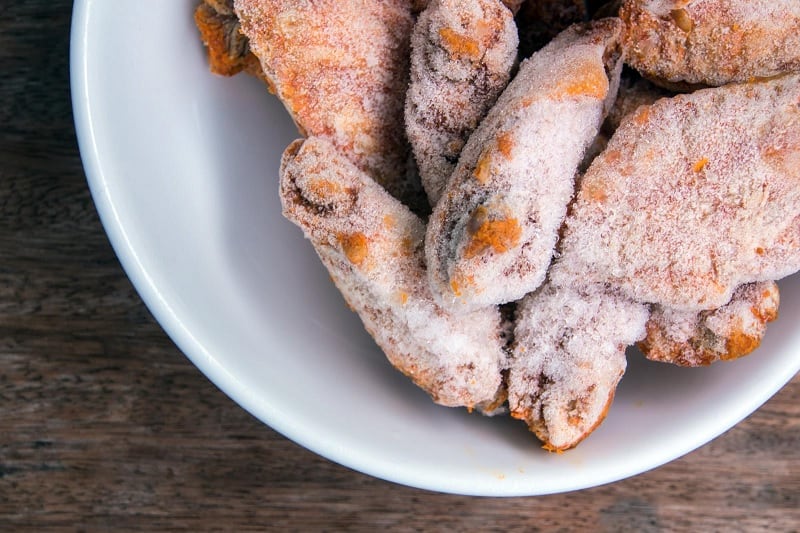
What’s the Safest Way to Defrost Chicken?
The safest way to defrost chicken is in the refrigerator. This method allows for a controlled, gradual thawing process at cooler temperatures, minimising the risk of bacterial growth on your food. Here are the steps you need to follow to do it:
- Place the chicken in its original packaging or a leak-proof plastic bag. This helps prevent cross-contamination and keeps any juices from the chicken contained.
- Put the chicken on a plate or in a shallow dish. This further prevents any potential drips from contaminating other foods in the refrigerator.
- Place the chicken in the refrigerator. Allow enough time for the chicken to thaw thoroughly. Generally, you should allow 24 hours of defrosting time for every 2.25 kg of chicken.
Remember that patience is key when using the refrigerator method. It’s a slow process, but it maintains a safe and consistent temperature and is the most reliable way to thaw chicken.
It also means you can wait longer between defrosting the chicken before cooking it, giving you greater flexibility over your mealtimes.
How Else Can You Safely Defrost Chicken?
If you need to speed up the defrosting process, you can use cold water or the microwave to thaw frozen chicken. However, these should be followed by immediate cooking to ensure food safety.
Here’s a brief look at both methods:
- Cold water: Place the chicken in a leak-proof plastic bag and submerge it in cold water. Change the water every 30 minutes to ensure that it stays cold. When using this method, it’s essential to cook the chicken immediately after it’s thawed.
- Microwave: Use the defrost setting on your microwave or microwave oven and follow the manufacturer’s instructions. Be cautious, as parts of the chicken may start to cook during the defrosting process. Cook the chicken promptly after thawing.
You might also be tempted to defrost chicken on the kitchen counter at room temperature. However, this is not recommended because it allows the chicken to enter the danger zone, where bacteria multiply rapidly. This can lead to foodborne illnesses.
Can You Cook Bacteria Out of Chicken?
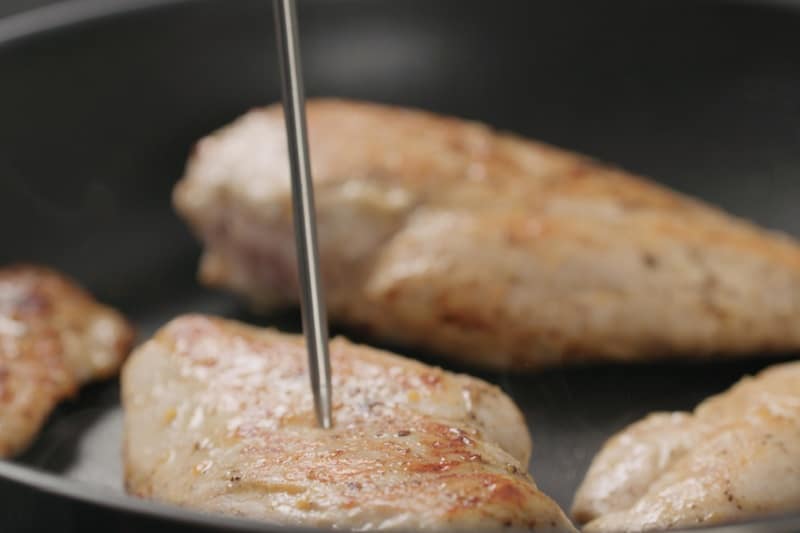
Cooking chicken thoroughly is effective in killing harmful bacteria that may be present. The minimum safe internal temperature for chicken is 74°C. Cooking chicken to this temperature ensures that the heat has penetrated the meat, destroying any harmful bacteria that might be present.
Always use a meat thermometer to ensure that the thickest part of the chicken reaches the recommended internal temperature of 74°C. This is a critical step in ensuring the safety of the chicken and preventing illnesses.
However, while cooking can eliminate bacteria, it’s important to note that it may not necessarily eliminate all toxins produced by certain bacteria.
Additionally, the longer chicken is held at temperatures within the danger zone, the more time bacteria have to produce toxins, even if they are later killed by cooking.
Therefore, always follow safe food handling practices to minimise the risk of bacterial contamination in the first place.
Can You Refreeze Thawed Chicken?
Refreezing thawed chicken is generally not recommended unless it has been cooked. Once the chicken is thawed, bacteria can multiply.
Refreezing does not eliminate the bacteria that may have multiplied during the thawing process and can actually lead to a higher bacterial load.
If you’ve thawed chicken and decide not to eat it immediately, it’s safer to cook it first and then freeze the cooked chicken.
Cooking the chicken kills any bacteria that may have multiplied during the thawing process. But remember – it cannot kill all the toxins produced by bacteria, so it’s still important to cook the defrosted chicken promptly.
To avoid having excess amounts of thawed chicken, freeze chicken portions separately. For example, chicken breasts can be frozen individually in freezer bags or wrapped tightly in clingfilm or tin foil, then placed in a freezer-safe container in the freezer. You can then quickly defrost the number of chicken breasts you need for a specific recipe.
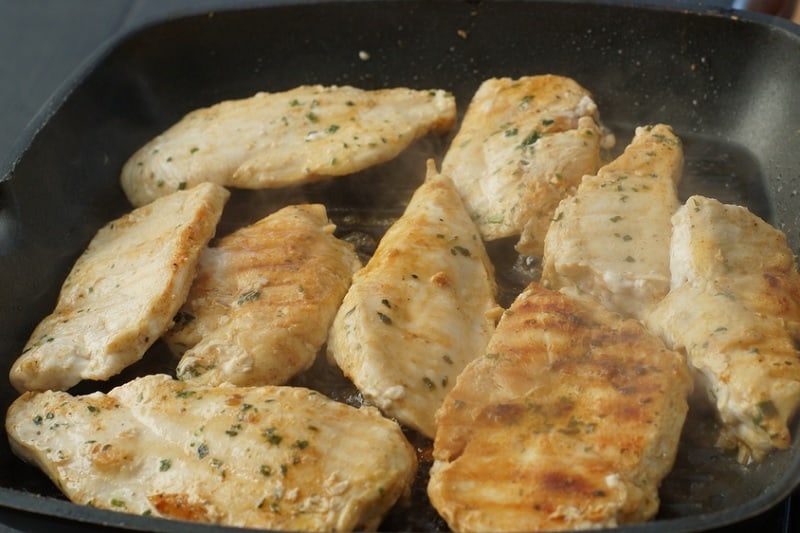
Other Tips for Cooking Chicken Safely
Not only is defrosting chicken safely important for food safety and hygiene – correct cooking and storage are also crucial in preventing foodborne illnesses. Here are tips you can follow:
- Use a food thermometer: Ensure that the thickest part of the chicken reaches an internal temperature of at least 74°C. This kills harmful bacteria that may have grown on the chicken and helps ensure it is safe to eat.
- Avoid cross-contamination: Use separate cutting boards and utensils for raw chicken to prevent cross-contamination with other foods. Wash hands, utensils, and surfaces thoroughly after handling raw chicken.
- Marinate safely: If marinating to add taste and prevent the chicken from drying out, do so in the refrigerator and not at room temperature to reduce the amount of bacterial growth. Discard any marinade that has come into contact with raw chicken.
- Refrigerate promptly: Refrigerate raw chicken promptly after purchase, defrosting, or preparation. Bacteria multiply rapidly at temperatures within the danger zone and can make your food unsafe to eat.
- Store at the right temperature: Keep raw chicken in the coldest part of the fridge and use it within two days of purchase. If not used within that time frame, freeze it for longer storage. Cooked chicken shouldn’t be left out either, but refrigerated within two hours of cooking.
- Thaw safely: Thaw frozen chicken in the refrigerator and use within two days, or defrost in cold water or the microwave for immediate use. Avoid thawing at room temperature, which can result in high levels of bad bacteria in the meat.
- Separate and seal: Store defrosted chicken in a leak-proof container or a sealed plastic bag to prevent juices from contaminating other foods as the meat defrosts. Similarly, raw chicken should be stored safely to avoid leakage.

Hannah is a freelance content writer and self-proclaimed foodie. When Hannah isn’t sitting tapping at her laptop, you’ll probably find her in the kitchen. As an ex-chalet host, she’s used to cooking four-course meals for 10+ people and loves feeding friends and family whenever possible.

